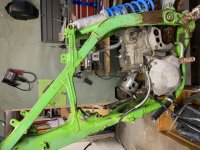Hello Everyone,
I am planning on building a dual sport electric motorcycle and am trying to find different motor / battery options that are available.
GOALS:
Power: 80ft/lb at the rear wheel, 40-60 hp, Minimum of 1 hour hard on/off road riding, curb weight around 250lbs

Price: materials that meet my needed goals at the best price/quality!
Motor:
I would like to do a 6:1 total gear ratio and the goal is a final rear wheel torque of 80ft/lb.
Meaning I need a motor that can produce a continuous 20Nm if my calculations are correct.
Also I would like to find a motor that will produce 30Kw, putting me around 40 hp.
I am looking at the Heinzmann PMS 150 price is $2,500
Link to Specs:
https://www.heinzmann.com/jdownloads/electric-and-hybrid-drives/CAT_Electric_Drives_Product_Catalogue_e.pdf
I believe I can get the desired torque of 20Nm and 30Kw out of this with a 96V 150Ah battery pack.
The price is not terrible for the motor but I do not necessarily need the Disc style and am wondering if I am paying for this technology.
However, I do like the benefits of the axial flux disc configutation.
Another option was Ashwood motors I am waiting on a response from them on any offerings they would have.
I had contacted Yasa, but the price was well beyond my means.
Does any one have any other motor options, or is there something I am missing in my thinking about the motor?
Here are some links to other motors I looked at and the reason I didnt think they would be suitable
Underpowered - http://www.asmokarts.com/index.cfm?pageID=24
Need to contract but probably our of price - https://emrax.com/e-motors/emrax-188/
Need to contact but probably out of price - https://avidtp.com/product/evo-motors/
(My ideal price would be below $1,000 on the motor)
Battery:
What seems to be reasonable for a battery is something that puts out 96V and 150 Amps.
Making that battery, and making it fit into a 250 lbs bike is very difficult.
Looking for any and all advice on battery manufacturers I can use for this build!
What seems to make the most sense is choosing a motor first then building a battery to fit
I am planning on building a dual sport electric motorcycle and am trying to find different motor / battery options that are available.
GOALS:
Power: 80ft/lb at the rear wheel, 40-60 hp, Minimum of 1 hour hard on/off road riding, curb weight around 250lbs
Price: materials that meet my needed goals at the best price/quality!
Motor:
I would like to do a 6:1 total gear ratio and the goal is a final rear wheel torque of 80ft/lb.
Meaning I need a motor that can produce a continuous 20Nm if my calculations are correct.
Also I would like to find a motor that will produce 30Kw, putting me around 40 hp.
I am looking at the Heinzmann PMS 150 price is $2,500
Link to Specs:
https://www.heinzmann.com/jdownloads/electric-and-hybrid-drives/CAT_Electric_Drives_Product_Catalogue_e.pdf
I believe I can get the desired torque of 20Nm and 30Kw out of this with a 96V 150Ah battery pack.
The price is not terrible for the motor but I do not necessarily need the Disc style and am wondering if I am paying for this technology.
However, I do like the benefits of the axial flux disc configutation.
Another option was Ashwood motors I am waiting on a response from them on any offerings they would have.
I had contacted Yasa, but the price was well beyond my means.
Does any one have any other motor options, or is there something I am missing in my thinking about the motor?
Here are some links to other motors I looked at and the reason I didnt think they would be suitable
Underpowered - http://www.asmokarts.com/index.cfm?pageID=24
Need to contract but probably our of price - https://emrax.com/e-motors/emrax-188/
Need to contact but probably out of price - https://avidtp.com/product/evo-motors/
(My ideal price would be below $1,000 on the motor)
Battery:
What seems to be reasonable for a battery is something that puts out 96V and 150 Amps.
Making that battery, and making it fit into a 250 lbs bike is very difficult.
Looking for any and all advice on battery manufacturers I can use for this build!
What seems to make the most sense is choosing a motor first then building a battery to fit




